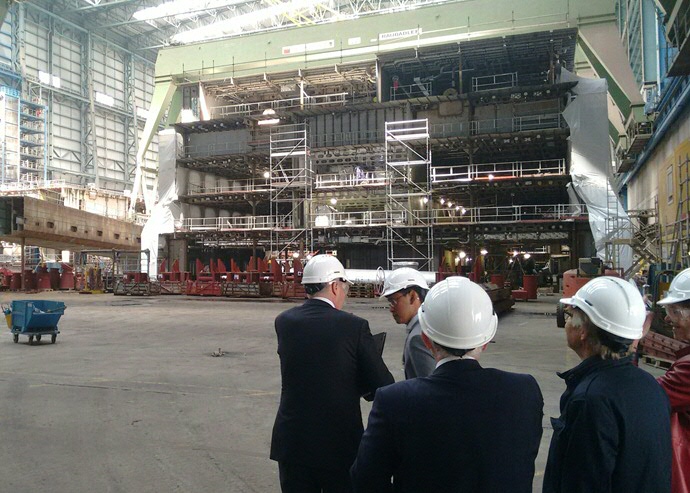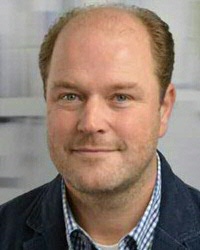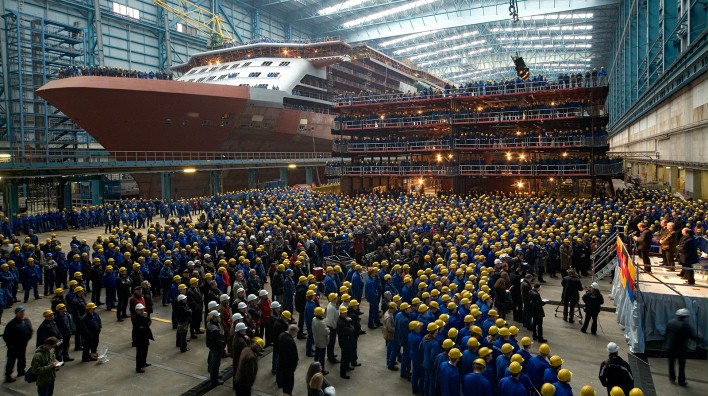Peter van Kampen on the collaboration with German institutions

The fourth-largest economy in the world lies just 50 km east of Groningen. Although the physical border with Germany may no longer amount to much, there are mental barriers that make collaboration between Dutch companies and the German profit and non-profit sector far from perfect. Peter van Kampen wants to change this. ‘It’s almost as if we’re in China faster than at our neighbours.’
Text: Gert Gritter, Communication UG
Van Kampen is deputy director of UGNWG (University of Groningen North West Germany), together with director Harald Orfgen. The UGNWG is a branch office of the UG in the German city of Papenburg, which has close links with institutions in northwest Germany, and he operates in the framework of Northern Knowledge. Economically, this region has a lot to offer, says Van Kampen. ‘There are a lot of businesses, for example UPM Nordland Papier in Dörpen, the biggest producer of printing paper in the world, and Meyer Werft in Papenburg, a shipyard that builds enormous cruise ships. But there are public authorities and many smaller businesses too.’
From Bremen to Den Helder
Van Kampen thinks ‘über-regionally’. ‘In the coming period, we want to intensify the on-site meetings between the UG and businesses in northwest Germany. The aim is to intensify the transfer of public-private knowledge from Bremen to Den Helder in North Holland, with the UG and its campus in Leeuwarden (Campus Fryslân) as partners and intermediaries. ‘We don’t focus on all of Germany, by the way, but on the northern Netherlands and northwest Germany. These areas have always known a lot of connectivity. There have always been cultural and historical similarities and relationships, in the areas of language, town and landscape planning, trade and religion. Don’t forget that Ubbo Emmius, the first rector of the UG, came from Eastern Friesland. The UG still has strong links with Germany and Germans. About 10% of the 30,000 students are German, and a further 500 Germans work here as researchers or lecturers, so it’s almost as if we’re a German university. I see myself primarily as a pioneer, an explorer. I make contacts in the region and reach flexible agreements with stakeholders such as border municipalities, businesses and public authorities. What strikes me is how little known the UG is; in the past we never put much effort into this. But I do notice that there is a lot of interest in Germany in working together. The UG has a strong international reputation. We have a 400-year tradition of academic excellence, but outsiders are often unaware of the specific research themes by which the UG differentiates itself.’

Employment
It is also important to see cooperation between the UG and northwest Germany in the field of employment. Van Kampen: ‘Thirty thousand young people are studying at an academic level at the UG and there are a few thousand academic researchers. This is very interesting for businesses in northwest Germany, which are always looking for qualified staff, and vice versa for interns and graduates because there are interesting career prospects for them.’ The UGNWG is located at Marienhospital Papenburg, with which the UG has a long-standing relationship. Among others, the UGNWG provides two-week placements for UG students at the Faculty of Medical Sciences. So far, more than 125 students have completed such a placement. Van Kampen: ‘As a continuation of these short placements, we are going to organize six-month ones for students who need to gain experience at a hospital emergency department as part of their medical training.’
Collaboration with Meyer Werft
The UGNWG’s biggest success so far is the collaboration agreement that the UG has signed with Meyer Werft Papenburg. Sibrand Poppema, at the time President of the Board of the University, and Tim Meyer, the director of Meyer, signed a memorandum of understanding for long-term cooperation on 23 July 2018. The two parties are joining forces in IB2050 (Innovation Lab Papenburg-Groningen 2018-2050). The aim is to come up with concrete, sustainable and competitive ideas for the business processes at Meyer Werft. Van Kampen: ‘Or, in simple terms, Meyer is interested in the question of how, as a German family business, it can keep its head above water in a very competitive sector. We can help them here with the knowledge that we develop and market at the UG.’

IT
The first three IB2050 projects relate to IT, sustainability reporting and energy efficiency. IT plays a major role in the Meyer Werft production environment. The shipyard is therefore exploring applications of the next generation of IT with the research group of Bayu Jayawardhana (Professor of Mechatronics and Control of Nonlinear Systems). Productivity can be increased by saving on costs and development time. The aim is to develop IT technology in which model-based approaches (‘digital twinning’) are combined with approaches based on big data.
Sustainability and energy efficiency
Meyer Werft is a world leader in ship building. It therefore wants to anticipate international standards for sustainability goals, such as GRIs (Global Reporting Initiatives). It has started a project with Alan Muller (Professor of International Management) to develop a system for internationally recognized and standardized reporting. Cruise ships use a lot of energy, which means that a shipyard such as Meyer Werft will want to build low-energy ships that are as efficient as possible. The group of Jacquelien Scherpen (Professor of Discreet Technology and Production Automation) is therefore going to conduct research together with the company in the area of energy efficiency, smart grids and renewable energy.
Future Rooms
Although Papenburg and Groningen are only 60 km from each other, a lot of direct contact and communication between the UG and Meyer Werft will be essential. Priority has therefore been given to setting up what are known as Future Rooms (FR) in both places. These rooms, which come equipped with advanced forms of communication, are where the project will be coordinated and will facilitate student and staff interaction. Travel between the two cities will therefore be limited. Zukunft-Raum Papenburg will be realized at the shipyard or in the city of Papenburg. The FR in Groningen will probably be in the Start-up City building on the UG’s Zernike Campus.
More news
-
15 September 2025
Successful visit to the UG by Rector of Institut Teknologi Bandung
